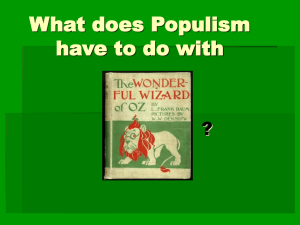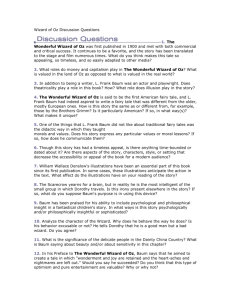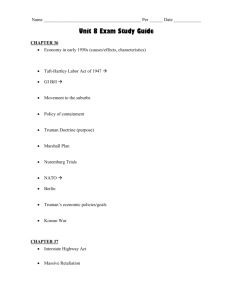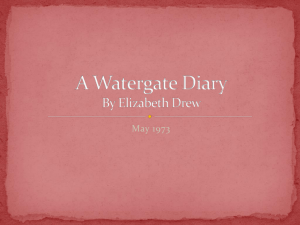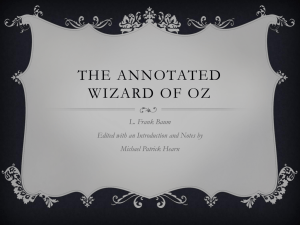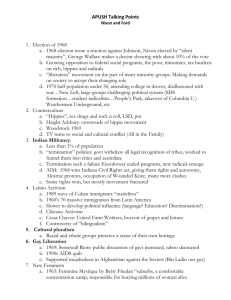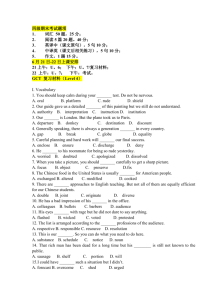The Great Plains Influence
advertisement
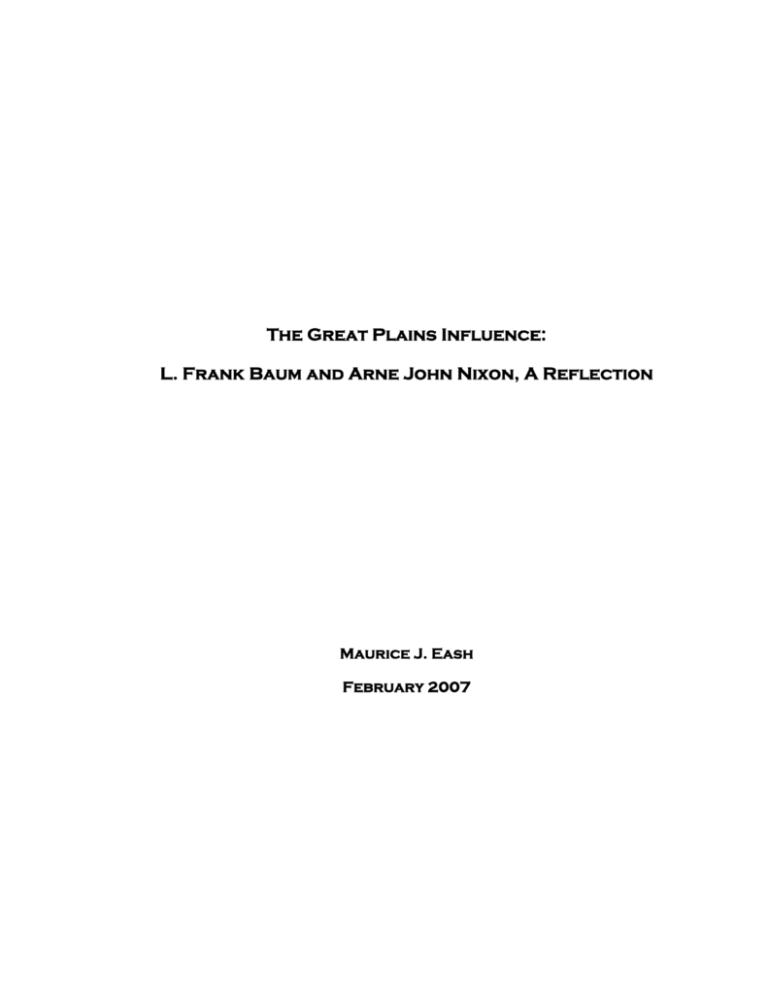
The Great Plains Influence: L. Frank Baum and Arne John Nixon, A Reflection Maurice J. Eash February 2007 I L. Frank Baum and Arne John Nixon never met. Baum had been deceased (1917) for almost a decade before Nixon was born in 1927. Although they lived out their lives in separate areas, they shared a common heritage of American political history: Populism. This “share the wealth more equitably philosophy” predominated in the Great Plains states and defined their political hero, i.e., William Jennings Bryan. Believing that their economic destiny was controlled by Eastern bankers who purposely relegated the agrarian West to poverty, Populism advocated free coinage of silver and gold; low interest rates on loans; and most extreme, a graduated income tax. The political thrust now appears to be archaic as much of the Populist platform has disappeared under the impact of Keynesian economics and the banking reforms of the New Deal, inaugurated of necessity by the Great Depression of the 1930s. A Populist political philosophy that was as ephemeral as the popular song “Somewhere over the Rainbow” in its practical consequences binds the lives of Baum and Nixon and gives new meaning to the author of The Wizard of Oz and a professor renowned as a practitioner of storytelling. This essay identifies and examines this shared framework that informed their lives and work: one as a writer, the other as a literary critic and storyteller. In the larger sense the ecosystem shaping their world stance is lodged in the history of the movement from a predominately rural population bound to agriculture, to the growth of mass urbanization of America. Both Baum and Nixon were greatly marked by their experience in the rural Great Plains of the United States, which is reflected in their respective interpretations: fictional characters and setting in Baum’s world; and critical, world interpretation of children’s literature in Nixon’s world. 1 Arne John Nixon first saw life in 1927 and spent his formative years on a farm –ranch in South Dakota; Lyman Frank Baum was born in a small town in Upstate New York, Chittenango, on May 15, 1856. While his father was well off by the socio-economic standards of the day, he essentially was raised in a rural environment where he did not attend formal school until he was 12 and then erratically. Eventually, after adjusting poorly to a rigid private military academy, his family relented and allowed him to continue schooling with a private tutor. As a young man searching for a career, he moved with his wife and small children to South Dakota where he served as a journalist on a small local newspaper. Baum and Nixon, however, as young adults gravitated to California and spent the majority of their adult years there. Baum published his first book in 1880 and the work he is most known for, The Wonderful Wizard of Oz, in 1900. This early life on the Great Plains of South Dakota impacted both men’s lives and was expressed in Baum’s major novel and underlay Nixon’s critical interpretations in storytelling. Nixon left no written records and this account draws heavily upon my memory of our many hours of discussion of Baum’s and others’ work during our friendship of forty-one years. He drew heavily on his Finnish-American background and always carried with him his experiential understanding of the effect of the hard scrabble life of his ranch family eking out a living in the Great Plains. Nixon told the story of being at a large gathering of FinnishAmericans and of being listed on the program for a session of story-telling. As he recounted, the program had hit a low spot with audience restlessness setting in from too many Finnish choirs singing too similar, chiefly J. S. Bach, numbers. In desperation, the MC grabbed Nixon behind the stage curtain. “For God’s sake, get out there and do something or we are going to have an audience revolt!” And with that admonition, he pushed Arne past the center fold of the curtain out to face the glare of flood lights and an edgy audience. Arne told me, “I spoke to them in my 2 native Finnish and what was noise retreated into a quiet rustle. Then I said, ‘You don’t understand; this was my first language, the one we spoke in the isolation of South Dakota.’ I could not discern faces, but the audience lapsed into complete silence. I launched into my prepared program of storytelling—in English. Nixon concluded: “It was not my first experience of chiding a Finnish-American audience on the loss of their culture.” Baum chose to locate the family of Dorothy, the heroine in The Wonderful Wizard of Oz, in Kansas that lies in the heart of the Great Plains. Nixon, it is safe to say, as a student of children’s literature, was not a member of the L. Frank Baum fan club and opined on numerous occasions that most of Baum’s literary production outside of his one major work (The Wonderful Wizard of Oz) had limited literary value. This one work, however, he considered to be Baum’s magnum opus, a masterpiece of subtlety using symbolism in setting an exquisite fairytale. In our forty-one-year friendship, Arne and I spent many pleasant hours discussing L. Frank Baum’s modern fairytale about a utopian land called Oz. It was only after Arne’s death in 1997 that I realized the impact of Baum and the degree of proximity of real and fictitious events in these two lives, lived in different eras, but sharing the age of political Populism and the special influence of the Great Plains of the United States. My reflections are largely drawn from the memories of our conversations. In reflection they examine some of the seminal events in the intersection of the lives of two contributors, one the author of the greatest of modern fairytales, the other as storyteller and interpreter children’s literature. Though separated by several decades, Baum and Nixon shared some similarities, one being that they were both left-handed and consequently wrote in that cramped wrist backward slant characteristic of the unreformed who failed to capitulate to the Palmer method of handwriting. 3 II The influence of living in the Great Plains was pronounced in both lives. Baum sets his story in the depth of the Great Plains. He spares no effort in his depiction of the harshness of the region and the toll it exacts on those who try to wrest a living by farming this implacable land. A region of bitterly cold winters and hot summers, it holds farmers and ranchers hostage to its unpredictable climate. Thinly populated, with constantly shifting settlements, this plain of 1,250,000 square miles covers parts of six states (Kansas, Texas, Oklahoma, Nebraska, North Dakota, and South Dakota) and contains many remains, often only foundations, of the homes of the disappointed and failed homesteaders. Despite vast population growth in the United State— it went from roughly 100 million to 300 million over Nixon’s lifetime—these Great Plains remain one of the most under-populated sections of the United States, at slightly more than five inhabitants per square mile. Arne often recounted the hardship that this harsh land imposed on his family through a succession of crop failures. Too little rain brought damaging, prolonged drought; too much rain and a planting season denied frequently ruined a wheat crop; crop disease could be stimulated by climatic extremes; grasshoppers not infrequently appeared in apocalyptic hordes and ate everything from grain to hay crops. It was, he said, as if everything natural conspired against these transplanted Finns as they settled in this new land. It exacted a heavy cost on the immigrants. More than once I heard Arne opine that the land should never have been ploughed and the native herds of antelope and bison displaced. In some unpublished remarks Arne made at the dedication of a Finnish Lutheran church as a historical landmark, he portrayed the settlers who are easily recognizable as Baum’s Dorothy’s Aunt Em and Uncle Henry. They came into this place of sanctuary, men on the right, women on the left, bodies bent from the burdens of heavy toil and care and 4 hardship. Their services were not marked with open expressions of happiness as they were embattled with the physical and spiritual elements, not infrequently in quiet desperation. In this house of worship they sought succor and guidance from their spiritual leaders. It was not lives that knew much ease until they gained the ranks of the community that composed the cemetery that frames this church. (Nixon, unpublished remarks, n.d.) There is an unmistakable resemblance to Nixon’s South Dakota Finns when Baum depicts Aunt Em and Uncle Henry as struggling to extract a living from the Great Plains in Kansas. When Aunt Em came to live in Kansas she was a pretty wife. The sun and wind had changed her. They had taken the sparkle from her eyes and left them a sober gray; they had taken the red from her cheeks and lips, and they were gray also. She was thin and almost never smiled. (Hearn, p. 92.) . . . Uncle Henry never laughed. He worked hard from morning to night and did not know what joy was. He was gray also, from his long beard to his rough boots, and he evoked stern and solemn, and rarely spoke. (Hearn, p. 93.) Their personages were marked as they became part of a culture heavily shaped by its environment. The isolation of wide open space, a sense of freedom, and extremes in temperature still leave their mark on the modern day residents of the Great Plains. A recent federal survey reported in The New York Times that the youth of this region drink to excess, and have more serious auto accidents than the national average. They also engage in more violent behavior than similar youth in large urban settings. It was not fortuitous that Baum featured a cyclone as the event to transition Dorothy from the plains of Kansas to the Land of Oz. In the past, critics have faulted Baum for meteorological inaccuracy in referring to a tornado as a cyclone. Nixon would have understood and stood with Baum who refused to change his terminology in subsequent editions. To change his storm 5 nomenclature would have rejected the common terminology for these violent storms in 19th century rural America. Once, as graduate students at Columbia University, Arne and I stood on Morningside Heights and watched the approach of a violent storm moving across the Hudson River from the Palisades of New Jersey. Arne spoke appreciatively of a childhood when these “cyclones” were not uncommon occurrences and that storm cellars were part of most prairie homes. He relished having first-hand experience with Baum’s cyclonic disturbance that served the purpose of Lewis Carroll’s metaphorical rabbit hole to transpose Dorothy’s life into an unseen underworld and to frame his modern fairytale. III In another modern context, Baum’s Aunt Em and Uncle Henry are pure American Gothic, famously portrayed in that most notable regional rural painting by the Iowa painter Grant Wood. As Wood portrayed Dorothy’s adopted aunt and uncle, it spoke directly to Nixon’s experience in rural life, as dictated by the geography of the Great Plains. Some years ago, the Worcester (Massachusetts) Art Museum hosted an exhibit of Grant Wood’s paintings and at my insistence Arne came from California to spend some time visiting the exhibit. From past experience I was well aware that it required a very strong pull to draw him away from his storytelling schedule and lecturing duties. We spent a glorious half day viewing the Wood exhibit and reminiscing about our agrarian youths. Wood, in his regional painting, captures a time that we both knew first-hand, particularly the activities surrounding the communal work of the threshing ring. Farmers cooperated, moving from farm to farm, to use the large machinery called a separator that separates grain from straw in threshing. Arne and I had both had personal experience working in a threshing ring, helping bring shocks of grain to the separator or handling 6 the grain produced. When too young to directly hold down a job entailing the heavier work with the grain, we carried water to the farm hands. Wood, in a 1934 painting, caught the central feature of the harvest dinner (now the educated would call it lunch) where the working farmers of the threshing ring sat down together for a large noon meal. Woods’ famous painting “Dinner for Threshers” is considered to be autobiographical. And it was for Arne and me. We could associate with the washing up in cold water, followed by a dinner serving mounds of fried chicken and mountains of mashed potatoes. It was a symbolic event not unrelated in the artistic organization of Leonardo’s painting of the Last Supper. Wanda M. Corn, in her critique of the Wood painting, sees the artist “. . . calling upon the traditions of Christian painting to sanctify the farmers’ repast” (Corn, p. 104). The painting is balanced in thirds (like a triptych), with the left end featuring the washing up of the sunburned men; the central focus depicts the crowded noon table; and the right end portrays women in the kitchen preparing food. A scene once familiar and treasured but now lost due to technological advancement is preserved only in the memories of those seventy and above. Uncle Henry and Aunt Em could have stepped directly into their roles in Grant Wood’s painting. Nixon and Baum experienced this agrarian culture shaping the residual Populist mind which produced a William Jennings Bryan. Bryan was a better showman than what he delivered, for he was repeatedly unsuccessful (three times a candidate) in gaining the presidency of the United States. He was, however, undoubtedly the choice of those around the threshers’ dinner table. Nevertheless, his call for lower rates on loans to farmers hit often by crop failures was not to be realized until the advent of the New Deal in the 1930s. 7 IV Baum sketches a series of utopias in Dorothy’s travels in the Land of Oz. These would not be completely foreign to the Finnish-American ranchers Nixon knew in coming of age in his rural South Dakota community. The promise of a utopia to these hard-pressed settlers beguiled some of them to forsake their tormented lives in the Great Plains for a utopia that was remaking the political and economic landscape of Russia. During the Great Depression of the 1930s, the Finnish community in the United States was approached by representatives of the newly established communist regime in the Soviet Union. If they would agree to come to the Soviet Union with their household goods, they were promised farmland and/or jobs. This wonderful, persuasive verbal picture of a utopia where joblessness was unknown, and a communist organization guaranteed security in basic needs of food and shelter as well as productive work fell on some receptive ears. One must remember these were, as Nixon knew, largely uneducated rancher-farmers with little knowledge of worlds outside their Great Plains communities. Radios and newspapers were largely unknown. There was little communication with Finland and even other sections of the United States. As a consequence, with the spiel from the representatives, some Finns signed on for resettlement, a new start in an unknown land. Many disappeared never to be heard from again; a few made their way back to the United States. Those who returned brought tales of savage mistreatment, their possessions seized upon arrival and themselves victimized by unfilled promises. The populist utopia was unmasked as a vicious authoritarian state bearing no resemblance to the original description. Arne attributed their being drawn into this web of utopian belief to an uninformed folk culture and anti-intellectualism that fueled the belief system of these largely illiterate settlers. They were taken in by the symbolism of a utopia, a perfect 8 society, that was resistant to a voracious capitalism that snared their lives with debt that could never be paid off and then confiscated their hard-won land. Baum came from a more affluent family and did not completely share these Populist sentiments. Arne always felt Baum’s depiction of folk culture in Oz signaled an endorsement of authoritarianism as the favored political organization in that each of Dorothy’s traveling companions inherited a kingdom and a kingship at the end of their adventure. The final images of Oz have only some characteristics of Populism, e.g., the governance structure is sensitive to needs of citizens, but is authoritarian in function—in brief, there is an inherent conviction of the wisdom of a monarch. Was Baum taken in by his knowledge of the royalty of Europe, especially Queen Victoria (reigned 1837 to 1901), a formidable presence in the world scene during his lifetime? V The Great Plains were the last great hunting ground of Native Americans. It is estimated that in the 18th century Indians west of the Mississippi River numbered 400,000. By the time Baum and Nixon had any experience with Native Americans, they were confined to reservations and ruled by the Bureau of Indian Affairs. Baum was much closer to the Indian Wars of the 1860s to 1880s. Arne did not have direct experience with Native Americans until he accepted a teaching post in the Makah Indian Reservation on the Olympic Peninsula in Washington state. He had applied through the mail and was accepted in a teaching post in 1949. Perhaps because of the context of their experience with Native Americans, Baum and Nixon held diametrically opposite viewpoints of Native American peoples and their culture. As an editor of a small town newspaper in Aberdeen, South Dakota, Baum wrote some scathing editorials on Native Americans in South Dakota which championed their repression and advocated their expulsion. These sentiments were later repudiated by Baum, but they were strong propaganda in the public 9 marketplace of opinion when published. The editorials, published in 1890, may have reflected a fear of Indians by settlers on the frontier for the Indian Wars were less than two decades in the past. The Battle of The Little Bighorn, where General Custer lost his life, and a heavy percentage of a company of the 7th Cavalry lost their lives, was a recent memory, having taken place in 1874. Moreover, the specter of attack by marauding Indians was foremost in the minds of he early settlers. Early frontier artists played upon those fears in paintings of Native American massacres. Near the time Baum authored his anti-Indian editorials, there had arisen a phenomenon among the Native Americans, recently relegated to reservations, the Ghost Dance (1889). Though it included transmogrification rituals, at its core it was a belief that a leader would be resurrected along with his dead warriors and he would lead them to freedom from their dreary reservation plight. A ritual employing a dance to call up dead warriors spread rapidly among the tribes. As the Ghost Dance spread, the Bureau of Indian Affairs fostered further angst in settlers by issuing warnings of the dangers of the Ghost Dance religion and forbidding its practice on reservations. In retrospect, it appears to have been of little threat to the civil or military government. And it appears that Baum’s editorials reflected the unease of the authorities. Later, his apology recognized that he had been less than accurate in his characterization of Native Americans. Nixon had much closer contact with a Native American tribe as he spent two years on the Nehah reservation on Neah Bay, Washington, where he taught teenage Native Americans. He made many friends and in the following years he undertook annual trips to visit his former students and their families. He enjoyed recounting an incident in which one of his former students, now a tribal judge, playfully threatened him with a court order if he did not prolong his 10 stay by two nights in order to participate in a salmon bake in his honor. As a teacher he was active in the community and was additionally assigned the honor of driving the bus transporting the athletic team. Over the years he retained his attachment to these students and often remarked about his sadness over the short lifespan of this cultural group. Nixon’s great capacity for relating to many different cultures, he felt, was shaped in large measure by his early teaching experience in Neah Bay. He was later to expand this side of his life in Africa, Asia, and Europe, when he lectured on and studied children’s literature. He didn’t fantasize about culture as Baum had in his masterpiece, but as a constructive literary critic he built upon his experience to find positive acceptance of a common humanity widely dispersed among nations. Baum, though widely traveled for a citizen of his time, did not incorporate any recognizable reality of those lands in his most famous tale in which Dorothy and her three companions traversed a variety of realms. Though exposed to a similar cultural heritage of Populism, Baum and Nixon drew on experiences that were vastly different in interpreting their world and portraying it as literature or dramatizing it in storytelling. In life experiences with a similar stimulus it is most vividly expressed in their contrasting views of Native Americans. VI Upon reflection, these two lives, though they were lived in different times, were exposed to and influenced by the geography of the place, the Great Plains. In their formative years, they felt the wind of a major political movement, Populism, that was active in this geographic region. It is helpful in clarifying the kaleidoscope view that confronts the examiner weighing the influences in these lives to consider three propositions: a) geography and political context do not matter; b) they do too matter; and c) geography and political context are all that matter. Too frequently starting from the first proposition in trying to identify the influential variables that 11 shape the life of a person, the examiner slips into the absolutism of the third proposition. While this paper reflects on the influence of geography and the political significance of Populism in the lives of L. Frank Baum and Arne John Nixon, it recognizes that the personal resources each brought to his life played a major role in determining his stance as author and literary criticstoryteller, respectively. The old issue of whether nature or nurture, treated as absolutes, determines the life outcome (i.e., would Adolph Hitler have become the Fuehrer with all its dreadful consequences if he had not flunked his entrance exam to art school?) is an approach that starts from proposition three and emerges in an interesting but overly emphatic view of the inherent nature of the subject. Using the limited data available for comparative purposes of these two lives, narrower parameters are deliberately circumscribed in a final summing up. Baum was born and spent his boyhood in rural Upstate New York where he experienced life as an upper class Yankee. The family was well off and indulged him in his childhood. His proclivity for fantasy over reality emerged early and continued throughout his adult life. He interposed elements of reality from the Great Plains in his major fairytale through his description of Dorothy, her Aunt Em and Uncle Henry. Dorothy’s companions, the Scarecrow, the Tin Woodman, and the Cowardly Lion were drawn from Baum’s fantasy and their symbolism seems cut from the whole cloth of his imagination. He was not, as a storyteller, above using a Horatio Alger, Jr., technique of accidental outside intervention to resolve conflicting ends and seemingly inscrutable dilemmas. When Dorothy and her companions are faced with an impossible problematic situation, Baum brings in flying monkeys to rescue the impossible situation that threatens his story line. Dorothy merited this intervention because she was, as were Alger’s central characters in his dime novels, virtuous. Baum seems to have had an arm’s-length relationship with religion and his fairytale largely escapes the moralizing emphasis that 12 influenced most children’s literature of his time. Nixon, too, was familiar with the fundamentalist religious views, having been raised in a family that attended a Finnish Lutheran Apostolic church. While these prevailed during his boyhood, he, as did Baum, refused to embrace the rigid moral strictures of these prairie churches which recoiled from complexity and held anti-intellectual views of science and literature. Nixon held a social philosophy that was free of the cant of the frontier and Horatio Alger, Jr., tales. Both men objected to the major religious thrusts of the day that interfered with the need for children to be free to think and explore without restriction. Baum never joined a formal church and Nixon gave up any pretense of religious affiliation during his early college years. He was fond of quoting from a line by H. L. Mencken, “When Satan thumbs my dossier, he will find I was once a member of the YMCA.” In his early college years he was secretary to the college chapter. By joining the movement to California, Baum and Nixon may be seen as turning their backs on the moral as well as the physical climate of the Great Plains. While each man resented the strait-jacketing of human intellect by the folk culture where birth had landed them, Nixon represented a more progressive political stance than Baum, who seemed to have little interest in politics. Nixon often remarked, “We learn what we live.” For him the social context in which we conduct education was a high priority. Storytelling with children was, for both men, to open an extended world of joy and wonderment. Nixon left no written records of his point of view or thoughts on his approach to storytelling and literary criticism of children’s literature. As I knew him over the forty plus years, covering his career as a professor teaching children’s literature and engaging in storytelling, some facts from our hours of discussion stand out. For many years Arne refused to discuss any conceptual structure of storytelling, especially as he practiced the art. Was it that he 13 didn’t want to give the game away and place what for him was almost a sacred trust in the cauldron of public argument? For we did from time to time argue and heatedly debate positions on issues. In his later years he did evolve and express his viewpoints on storytelling and the uses of children’s literature. Some of his preferences and views can be traced back to his mentor in children’s literature at Teachers College, Columbia University, Professor Leland B. Jacobs, himself a masterful teacher and a recognized authority in storytelling. One admonition I recall Arne quoting Professor Jacobs on performing as a storyteller was, “Never in a program follow a trained dog act or small children.” In a more serious vein, Arne often expounded a strongly held belief inherited from his relationship to Professor Jacobs: “The development of character in the story line is more important than the plot.” Both student and mentor had distinctive dramatic voices that they used to great advantage. Arne readily admitted that he was an admirer of the British actor Charles Laughton (1899-1962) and had learned from his recordings of dramatic readings. In examining the labels of Laughton’s recordings, now out of print, one is struck by the similarity with Arne’s preferences in literature. Both loved those authors who prized good stories with unforgettable characters: Twain, Dickens, Shaw, and Wells. They both had a very wide acquaintance with literature and Arne lived his last years deeply disappointed with the ignorance that classroom teachers manifest of literature, a falling-away that he believed was profound and increasing with the lack of reading on the part of teachers. Later in his career Arne developed a utilitarian view of the use of children’s literature. In clearing his office after his death (1997), extensive files on theme-related courses designed specifically for classroom teachers were in evidence: “A Lively Fossil That Will Not Die: Folktales”; “The Oldest and Best Literature for Children”; “Fantasy Stories, Tales of Wonder and Magic”; “Contemporary and Historical Realistic Fiction for Children”; Sharing Literature 14 Through Storytelling”; Books That Deal with Many Historical Themes”; Stories and Poetry for the Holidays”; “Using Readers Theatre and Choral Speaking.” In looking at the few examples of written pieces that he composed, one is impressed by the quality of his writing. Why he and his mentor, Professor Jacobs, were reluctant to put their thoughts to paper must remain a mystery. Arne and I spent a last wonderful afternoon with Professor Jacobs in 1990. He died in 1992. Both mentor and student had dedicated much of their lives to the propagation of storytelling as a legitimate classroom experience and promoted the use of children’s literature by classroom teachers. There has been much good clean fun with Baum’s famous fairytale as an allegory of Populist politics in the late 1880s. Critics, only semi-seriously, analyzed it as a bundle of cleverly concealed symbolism that expressed in a thinly disguised fairytale the repression of agrarian America by bankers and moneyed financiers of the East in the latter part of the 19th century (e.g., the Wicked Witches represent bankers). This interpretation and others have largely been discounted as not creditable nor accurately reflecting Baum’s intentions. Still, the symbolism that enriches Baum’s masterpiece as a first-class fairytale and keeps it fresh in the cultural imagination lives. Recently, a soldier who had just returned from a tour of duty in Iraq referred to this country as Oz. In his follow-up remarks, he labeled the Green Zone, the tightly defended section of Baghdad that houses the government and military headquarters as “The Emerald City.” Both Baum and Nixon would have appreciated the irony of this imaginative G.I. 15 Sources Brown, David S. (2006). Richard Hofstadter: An intellectual biography. Chicago: University of Chicago Press. Callow, Susan. (1988). Charles Laughton: A difficult actor. New York: Grove Press. Carpenter, Angelica S., & Shirley, Jean. (1992). L. Frank Baum: Royal historian. Minneapolis: Lerner Publishing Group. Corn, Wanda. (1983). Grant woos the regionalist vision. New Haven: Yale University Press. Hearn, Michael P. (1973). The annotated Wizard of Oz. New York: Clarkson N. Potter, Inc. Nixon, Arne John. (n.d.). Unpublished remarks at the dedication of the Finnish Lutheran Church, Frederick, S.D. From document fragments found by the author after Nixon’s death, upon clearing out Nixon’s office at California State University, Fresno, California. Utely, Robert M., & Wilcomb E. Washburn. (1992). The Indian Wars. New York: American Heritage Publishing. 16
